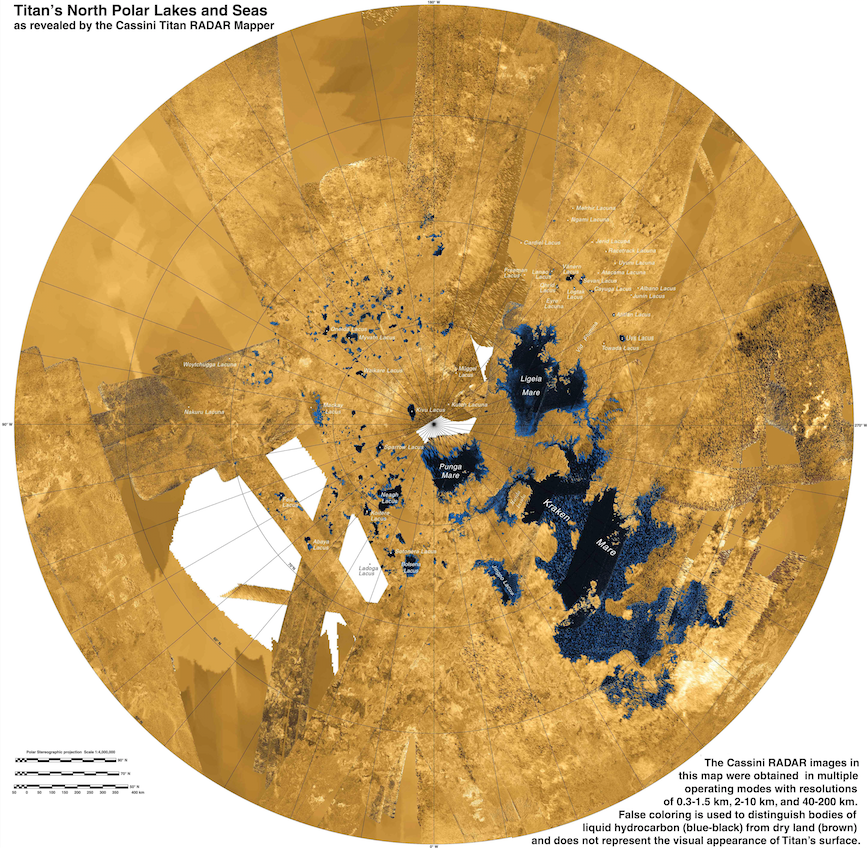Titan, the largest moon of Saturn, is known for its surface lakes and seas filled with liquid hydrocarbons. The Cassini spacecraft, which had been gazing at the saturnian system from 2004 to 2017, observed a methane cycle similar to the hydrological cycle on Earth and detected lakes and seas filled with liquid hydrocarbons (mainly methane and ethane). These surface lakes and seas are not the only liquid bodies on Titan; there is also a global ocean filled with water lying beneath its icy surface.
Image credit: NASA/JPL-Caltech/ASI/USGS The 2D depth-averaged model has been used to study the tides of Kraken and Ligeia Maria (the largest seas of Titan), Ontario Lacus (the largest lake in the southern hemisphere), and of the global subsurface ocean. SLIM is well suited to study such barotropic flows and to conduct sensitivity analysis over the poorly constrained parameters (bottom friction, surface deformation, bathymetry, …). It is able to accurately represent the lakes and seas complex shorelines. Unexplained phenomena such as the shoreline variations (in Ontario Lacus), and the observed bright spot appearance/disappearance (the co-called Magic Islands phenomena in the northern seas) are studied by means of the wetting and drying algorithm. The flow predicted by SLIM could also be used to design future observation missions on Titan.
The sea surface elevation (in meters) induced by the tides in Kraken and Ligeia Maria is shown below. The highest/lowest tides occurs 0.31 Titan day after perikron/apokron in the south-eastern part of Kraken 2. The tidal motion in Kraken 1 and Ligeia Mare can be represented by a sloshing wave mode while there is an amphidromic point in Kraken 1. The tidal motion is independent in each basin, which can results in sea surface elevation positive at one end of the strait and negative at the other. In such case, a significant sea surface elevation gradient occurs in the strait(s), which results in strong flow.
External collaborators
Prof. Véronique Dehant and Dr Özgür Karatekin (Royal Observatory of Belgium)
To learn more…
778265
titan
items
1
0
date
desc
4713
https://www.slim-ocean.be/wp-content/plugins/zotpress/
%7B%22status%22%3A%22success%22%2C%22updateneeded%22%3Afalse%2C%22instance%22%3A%22zotpress-76ee1e49417ab867b86e55354f993537%22%2C%22meta%22%3A%7B%22request_last%22%3A0%2C%22request_next%22%3A0%2C%22used_cache%22%3Atrue%7D%2C%22data%22%3A%5B%7B%22key%22%3A%22RHP447JS%22%2C%22library%22%3A%7B%22id%22%3A778265%7D%2C%22meta%22%3A%7B%22creatorSummary%22%3A%22Vincent%20et%20al.%22%2C%22parsedDate%22%3A%222022%22%2C%22numChildren%22%3A1%7D%2C%22bib%22%3A%22%3Cdiv%20class%3D%5C%22csl-bib-body%5C%22%20style%3D%5C%22line-height%3A%202%3B%20padding-left%3A%201em%3B%20text-indent%3A-1em%3B%5C%22%3E%5Cn%20%20%3Cdiv%20class%3D%5C%22csl-entry%5C%22%3EVincent%2C%20D.%2C%20Lambrechts%2C%20J.%2C%20Tyler%2C%20R.%20H.%2C%20Karatekin%2C%20%26%23xD6%3B.%2C%20Dehant%2C%20V.%2C%20%26amp%3B%20Deleersnijder%2C%20%26%23xC9%3B.%20%282022%29.%20A%20numerical%20study%20of%20the%20liquid%20motion%20in%20Titan%26%23x2019%3Bs%20subsurface%20ocean.%20%3Ci%3EIcarus%3C%5C%2Fi%3E%2C%20%3Ci%3E388%3C%5C%2Fi%3E%2C%20115219.%20%3Ca%20href%3D%27https%3A%5C%2F%5C%2Fdoi.org%5C%2F10.1016%5C%2Fj.icarus.2022.115219%27%3Ehttps%3A%5C%2F%5C%2Fdoi.org%5C%2F10.1016%5C%2Fj.icarus.2022.115219%3C%5C%2Fa%3E%3C%5C%2Fdiv%3E%5Cn%3C%5C%2Fdiv%3E%22%2C%22data%22%3A%7B%22itemType%22%3A%22journalArticle%22%2C%22title%22%3A%22A%20numerical%20study%20of%20the%20liquid%20motion%20in%20Titan%5Cu2019s%20subsurface%20ocean%22%2C%22creators%22%3A%5B%7B%22creatorType%22%3A%22author%22%2C%22firstName%22%3A%22David%22%2C%22lastName%22%3A%22Vincent%22%7D%2C%7B%22creatorType%22%3A%22author%22%2C%22firstName%22%3A%22Jonathan%22%2C%22lastName%22%3A%22Lambrechts%22%7D%2C%7B%22creatorType%22%3A%22author%22%2C%22firstName%22%3A%22Robert%20H.%22%2C%22lastName%22%3A%22Tyler%22%7D%2C%7B%22creatorType%22%3A%22author%22%2C%22firstName%22%3A%22%5Cu00d6zg%5Cu00fcr%22%2C%22lastName%22%3A%22Karatekin%22%7D%2C%7B%22creatorType%22%3A%22author%22%2C%22firstName%22%3A%22V%5Cu00e9ronique%22%2C%22lastName%22%3A%22Dehant%22%7D%2C%7B%22creatorType%22%3A%22author%22%2C%22firstName%22%3A%22%5Cu00c9ric%22%2C%22lastName%22%3A%22Deleersnijder%22%7D%5D%2C%22abstractNote%22%3A%22An%20ocean%20filled%20with%20liquid%20water%20lies%20beneath%20the%20icy%20surface%20of%20several%20Jovian%20and%20Saturnian%20moons.%20In%20such%20an%20ocean%2C%20the%20currents%20are%20driven%20by%20various%20phenomena%20such%20as%20the%20tidal%20forcing%2C%20the%20deformation%20of%20the%20ice%20shell%20lying%20at%20its%20top%2C%20the%20temperature%20gradient%20resulting%20from%20the%20surface%20and%20bottom%20heat%20fluxes.%20.%20.%20The%20flow%20induced%20by%20the%20first%20two%20forcings%20can%20be%20modelled%20by%20means%20of%20a%202D%20depth-averaged%20model%2C%20while%20the%20third%20one%20generates%20horizontal%20and%20vertical%20density%20variations%20whose%20effects%20can%20only%20be%20captured%20by%20a%203D%20baroclinic%20model.%22%2C%22date%22%3A%2212%5C%2F2022%22%2C%22language%22%3A%22en%22%2C%22DOI%22%3A%2210.1016%5C%2Fj.icarus.2022.115219%22%2C%22ISSN%22%3A%2200191035%22%2C%22url%22%3A%22https%3A%5C%2F%5C%2Flinkinghub.elsevier.com%5C%2Fretrieve%5C%2Fpii%5C%2FS0019103522003165%22%2C%22collections%22%3A%5B%22GJSQZPDC%22%5D%2C%22dateModified%22%3A%222023-03-07T18%3A59%3A40Z%22%7D%7D%2C%7B%22key%22%3A%22TPVAGHVG%22%2C%22library%22%3A%7B%22id%22%3A778265%7D%2C%22meta%22%3A%7B%22creatorSummary%22%3A%22Vincent%20et%20al.%22%2C%22parsedDate%22%3A%222019-08-31%22%2C%22numChildren%22%3A1%7D%2C%22bib%22%3A%22%3Cdiv%20class%3D%5C%22csl-bib-body%5C%22%20style%3D%5C%22line-height%3A%202%3B%20padding-left%3A%201em%3B%20text-indent%3A-1em%3B%5C%22%3E%5Cn%20%20%3Cdiv%20class%3D%5C%22csl-entry%5C%22%3EVincent%2C%20D.%2C%20Lambrechts%2C%20J.%2C%20Karatekin%2C%20%26%23xD6%3B.%2C%20Van%20Hoolst%2C%20T.%2C%20Tyler%2C%20R.%20H.%2C%20Dehant%2C%20V.%2C%20%26amp%3B%20Deleersnijder%2C%20E.%20%282019%29.%20Normal%20modes%20and%20resonance%20in%20Ontario%20Lacus%3A%20a%20hydrocarbon%20lake%20of%20Titan.%20%3Ci%3EOcean%20Dynamics%3C%5C%2Fi%3E.%20%3Ca%20href%3D%27https%3A%5C%2F%5C%2Fdoi.org%5C%2F10.1007%5C%2Fs10236-019-01290-2%27%3Ehttps%3A%5C%2F%5C%2Fdoi.org%5C%2F10.1007%5C%2Fs10236-019-01290-2%3C%5C%2Fa%3E%3C%5C%2Fdiv%3E%5Cn%3C%5C%2Fdiv%3E%22%2C%22data%22%3A%7B%22itemType%22%3A%22journalArticle%22%2C%22title%22%3A%22Normal%20modes%20and%20resonance%20in%20Ontario%20Lacus%3A%20a%20hydrocarbon%20lake%20of%20Titan%22%2C%22creators%22%3A%5B%7B%22creatorType%22%3A%22author%22%2C%22firstName%22%3A%22David%22%2C%22lastName%22%3A%22Vincent%22%7D%2C%7B%22creatorType%22%3A%22author%22%2C%22firstName%22%3A%22Jonathan%22%2C%22lastName%22%3A%22Lambrechts%22%7D%2C%7B%22creatorType%22%3A%22author%22%2C%22firstName%22%3A%22%5Cu00d6zg%5Cu00fcr%22%2C%22lastName%22%3A%22Karatekin%22%7D%2C%7B%22creatorType%22%3A%22author%22%2C%22firstName%22%3A%22Tim%22%2C%22lastName%22%3A%22Van%20Hoolst%22%7D%2C%7B%22creatorType%22%3A%22author%22%2C%22firstName%22%3A%22Robert%20H.%22%2C%22lastName%22%3A%22Tyler%22%7D%2C%7B%22creatorType%22%3A%22author%22%2C%22firstName%22%3A%22V%5Cu00e9ronique%22%2C%22lastName%22%3A%22Dehant%22%7D%2C%7B%22creatorType%22%3A%22author%22%2C%22firstName%22%3A%22Eric%22%2C%22lastName%22%3A%22Deleersnijder%22%7D%5D%2C%22abstractNote%22%3A%22The%20natural%20modes%20of%20Ontario%20Lacus%20surface%20oscillations%2C%20the%20largest%20lake%20in%20Titan%5Cu2019s%20southern%20hemisphere%2C%20are%20simulated%20and%20analyzed%20as%20they%20are%20potentially%20of%20broad%20interest%20in%20a%20variety%20of%20dynamical%20researches.%20We%20found%20that%20tidal%20forces%20are%20too%20low%20in%20frequency%20to%20excite%20the%20%28barotropic%29%20normal%20modes.%20Broadband%20wind%20forcing%20likely%20spans%20the%20resonant%20frequencies.%20High%20wind%20speed%2C%20which%20could%20be%20encountered%20under%20episodic%20phenomena%20such%20as%20storms%2C%20would%20be%20required%20to%20significantly%20excite%20the%20normal%20modes.%20While%20the%20slower%20baroclinic%20normal%20modes%20could%20more%20easily%20be%20resonantly%20forced%20by%20the%20low-frequency%20tidal%20forces%2C%20addressing%20this%20issue%20demands%20unavailable%20information%20about%20the%20lake%20stratification.%22%2C%22date%22%3A%222019-8-31%22%2C%22language%22%3A%22en%22%2C%22DOI%22%3A%2210.1007%5C%2Fs10236-019-01290-2%22%2C%22ISSN%22%3A%221616-7341%2C%201616-7228%22%2C%22url%22%3A%22http%3A%5C%2F%5C%2Flink.springer.com%5C%2F10.1007%5C%2Fs10236-019-01290-2%22%2C%22collections%22%3A%5B%22GJSQZPDC%22%5D%2C%22dateModified%22%3A%222023-03-07T18%3A59%3A30Z%22%7D%7D%2C%7B%22key%22%3A%222PE5KVFJ%22%2C%22library%22%3A%7B%22id%22%3A778265%7D%2C%22meta%22%3A%7B%22creatorSummary%22%3A%22Vincent%20et%20al.%22%2C%22parsedDate%22%3A%222018%22%2C%22numChildren%22%3A2%7D%2C%22bib%22%3A%22%3Cdiv%20class%3D%5C%22csl-bib-body%5C%22%20style%3D%5C%22line-height%3A%202%3B%20padding-left%3A%201em%3B%20text-indent%3A-1em%3B%5C%22%3E%5Cn%20%20%3Cdiv%20class%3D%5C%22csl-entry%5C%22%3EVincent%2C%20D.%2C%20Karatekin%2C%20%26%23xD6%3B.%2C%20Lambrechts%2C%20J.%2C%20Lorenz%2C%20R.%20D.%2C%20Dehant%2C%20V.%2C%20%26amp%3B%20Deleersnijder%2C%20%26%23xC9%3B.%20%282018%29.%20A%20numerical%20study%20of%20tides%20in%20Titan%26%23x2032%3Bs%20northern%20seas%2C%20Kraken%20and%20Ligeia%20Maria.%20%3Ci%3EIcarus%3C%5C%2Fi%3E%2C%20%3Ci%3E310%3C%5C%2Fi%3E%2C%20105%26%23x2013%3B126.%20%3Ca%20href%3D%27https%3A%5C%2F%5C%2Fdoi.org%5C%2F10.1016%5C%2Fj.icarus.2017.12.018%27%3Ehttps%3A%5C%2F%5C%2Fdoi.org%5C%2F10.1016%5C%2Fj.icarus.2017.12.018%3C%5C%2Fa%3E%3C%5C%2Fdiv%3E%5Cn%3C%5C%2Fdiv%3E%22%2C%22data%22%3A%7B%22itemType%22%3A%22journalArticle%22%2C%22title%22%3A%22A%20numerical%20study%20of%20tides%20in%20Titan%5Cu2032s%20northern%20seas%2C%20Kraken%20and%20Ligeia%20Maria%22%2C%22creators%22%3A%5B%7B%22creatorType%22%3A%22author%22%2C%22firstName%22%3A%22David%22%2C%22lastName%22%3A%22Vincent%22%7D%2C%7B%22creatorType%22%3A%22author%22%2C%22firstName%22%3A%22%5Cu00d6zg%5Cu00fcr%22%2C%22lastName%22%3A%22Karatekin%22%7D%2C%7B%22creatorType%22%3A%22author%22%2C%22firstName%22%3A%22Jonathan%22%2C%22lastName%22%3A%22Lambrechts%22%7D%2C%7B%22creatorType%22%3A%22author%22%2C%22firstName%22%3A%22Ralph%20D.%22%2C%22lastName%22%3A%22Lorenz%22%7D%2C%7B%22creatorType%22%3A%22author%22%2C%22firstName%22%3A%22V%5Cu00e9ronique%22%2C%22lastName%22%3A%22Dehant%22%7D%2C%7B%22creatorType%22%3A%22author%22%2C%22firstName%22%3A%22%5Cu00c9ric%22%2C%22lastName%22%3A%22Deleersnijder%22%7D%5D%2C%22abstractNote%22%3A%22The%20tidal%20response%20of%20Titan%20s%20two%20largest%20northern%20seas%2C%20Ligeia%20Mare%20and%20Kraken%20Mare%2C%20is%20studied%20by%20means%20of%20a%20two-dimensional%2C%20depth-averaged%2C%20shallow%20water%20model%2C%20SLIM%20%28http%3A%5C%2F%5C%2Fwww.climate.be%5C%2Fslim%29.%20Kraken%20Mare%20is%20formed%20of%20two%20basins%2C%20the%20northern%20one%20being%20assumed%20to%20be%20linked%20by%20a%20single%20strait%2C%20Trevize%20Fretum%2C%20to%20Ligeia%20Mare.%20The%20tidal%20motions%20tend%20to%20be%20independent%20of%20each%20other%20in%20each%20basin%20%28i.e.%2C%20Ligeia%20Mare%2C%20Kraken%201%20and%20Kraken%202%29%20which%20results%20in%20sharp%20transitions%20in%20the%20straits.%20Our%20results%20are%20overall%20rather%20similar%20to%20those%20of%20Tokano%20et%20al.%20%282014%29%2C%20suggesting%20that%20a%202D%20model%20such%20as%20SLIM%20is%20adequate%20for%20modelling%20Titan%20s%20tides%20and%2C%20since%20it%20is%20%28presumably%29%20less%20computationally%20demanding%2C%20may%20be%20better%20for%20sensitivity%20studies.%20For%20instance%2C%20the%20maximum%20tidal%20range%20in%20Kraken%20and%20Ligeia%20Maria%20respectively%20are%200.29%20m%20and%200.14%20m%2C%20which%20is%20within%20the%20range%20predicted%20by%20Lorenz%20et%20al.%20%282014%29%20although%20smaller%20by%200.07%20m%20and%20larger%20by%200.04%20m%20than%20the%20estimates%20of%20Tokano%20et%20al.%20%282014%29%20%28but%20it%20occurs%20at%20the%20same%20location%29.%20The%20tidal%20currents%20are%20faster%20%28by%20about%20one%20order%20of%20magnitude%29%20in%20the%20straits%20linking%20those%20Maria%20than%20in%20the%20basins%20themselves%20%28with%20a%20maximum%20of%200.36%20m%5C%2Fs%20in%20the%20strait%20linking%20Kraken%201%20and%20Kraken%202%2C%20Seldon%20Fretum%29.%20A%20decomposition%20of%20the%20tidal%20history%20into%20different%20harmonic%20components%20is%20carried%20out.%20Except%20in%20speci%5Cufb01c%20areas%20such%20as%20the%20straits%20and%20the%20amphidromic%20point%28s%29%2C%20the%20main%20tidal%20component%20has%20a%20period%20of%201%20Titan%20Day.%20We%20also%20brie%5Cufb02y%20studied%20the%20eigenmodes%20of%20the%20northern%20seas%20whose%20period%20is%20close%20to%20the%20tidal%20period%3A%20such%20modes%20are%20very%20local.%20Indeed%2C%20their%20magnitude%20is%20signi%5Cufb01cant%20%28with%20respect%20to%20the%20magnitude%20of%20the%20modes%20elsewhere%20in%20the%20seas%29%20in%20small%20bay%28s%29%20or%20near%20the%20islands%20of%20Kraken%202%20and%20Ligeia%20Mare.%20They%20are%20not%20excited%20by%20the%20tides%20as%20they%20do%20not%20appear%20in%20the%20tidal%20motion.%22%2C%22date%22%3A%2208%5C%2F2018%22%2C%22language%22%3A%22en%22%2C%22DOI%22%3A%2210.1016%5C%2Fj.icarus.2017.12.018%22%2C%22ISSN%22%3A%2200191035%22%2C%22url%22%3A%22https%3A%5C%2F%5C%2Flinkinghub.elsevier.com%5C%2Fretrieve%5C%2Fpii%5C%2FS0019103517305055%22%2C%22collections%22%3A%5B%22GJSQZPDC%22%5D%2C%22dateModified%22%3A%222018-10-21T09%3A57%3A42Z%22%7D%7D%2C%7B%22key%22%3A%22A37KES8N%22%2C%22library%22%3A%7B%22id%22%3A778265%7D%2C%22meta%22%3A%7B%22creatorSummary%22%3A%22Vincent%20et%20al.%22%2C%22parsedDate%22%3A%222016%22%2C%22numChildren%22%3A2%7D%2C%22bib%22%3A%22%3Cdiv%20class%3D%5C%22csl-bib-body%5C%22%20style%3D%5C%22line-height%3A%202%3B%20padding-left%3A%201em%3B%20text-indent%3A-1em%3B%5C%22%3E%5Cn%20%20%3Cdiv%20class%3D%5C%22csl-entry%5C%22%3EVincent%2C%20D.%2C%20Karatekin%2C%20%26%23xD6%3B.%2C%20Vallaeys%2C%20V.%2C%20Hayes%2C%20A.%20G.%2C%20Mastrogiuseppe%2C%20M.%2C%20Notarnicola%2C%20C.%2C%20Dehant%2C%20V.%2C%20%26amp%3B%20Deleersnijder%2C%20E.%20%282016%29.%20Numerical%20study%20of%20tides%20in%20Ontario%20Lacus%2C%20a%20hydrocarbon%20lake%20on%20the%20surface%20of%20the%20Saturnian%20moon%20Titan.%20%3Ci%3EOcean%20Dynamics%3C%5C%2Fi%3E%2C%20%3Ci%3E66%3C%5C%2Fi%3E%284%29%2C%20461%26%23x2013%3B482.%20%3Ca%20href%3D%27https%3A%5C%2F%5C%2Fdoi.org%5C%2F10.1007%5C%2Fs10236-016-0926-2%27%3Ehttps%3A%5C%2F%5C%2Fdoi.org%5C%2F10.1007%5C%2Fs10236-016-0926-2%3C%5C%2Fa%3E%3C%5C%2Fdiv%3E%5Cn%3C%5C%2Fdiv%3E%22%2C%22data%22%3A%7B%22itemType%22%3A%22journalArticle%22%2C%22title%22%3A%22Numerical%20study%20of%20tides%20in%20Ontario%20Lacus%2C%20a%20hydrocarbon%20lake%20on%20the%20surface%20of%20the%20Saturnian%20moon%20Titan%22%2C%22creators%22%3A%5B%7B%22creatorType%22%3A%22author%22%2C%22firstName%22%3A%22David%22%2C%22lastName%22%3A%22Vincent%22%7D%2C%7B%22creatorType%22%3A%22author%22%2C%22firstName%22%3A%22%5Cu00d6zgur%22%2C%22lastName%22%3A%22Karatekin%22%7D%2C%7B%22creatorType%22%3A%22author%22%2C%22firstName%22%3A%22Valentin%22%2C%22lastName%22%3A%22Vallaeys%22%7D%2C%7B%22creatorType%22%3A%22author%22%2C%22firstName%22%3A%22Alexander%20G.%22%2C%22lastName%22%3A%22Hayes%22%7D%2C%7B%22creatorType%22%3A%22author%22%2C%22firstName%22%3A%22Marco%22%2C%22lastName%22%3A%22Mastrogiuseppe%22%7D%2C%7B%22creatorType%22%3A%22author%22%2C%22firstName%22%3A%22Claudia%22%2C%22lastName%22%3A%22Notarnicola%22%7D%2C%7B%22creatorType%22%3A%22author%22%2C%22firstName%22%3A%22V%5Cu00e9ronique%22%2C%22lastName%22%3A%22Dehant%22%7D%2C%7B%22creatorType%22%3A%22author%22%2C%22firstName%22%3A%22Eric%22%2C%22lastName%22%3A%22Deleersnijder%22%7D%5D%2C%22abstractNote%22%3A%22%22%2C%22date%22%3A%224%5C%2F2016%22%2C%22language%22%3A%22en%22%2C%22DOI%22%3A%2210.1007%5C%2Fs10236-016-0926-2%22%2C%22ISSN%22%3A%221616-7341%2C%201616-7228%22%2C%22url%22%3A%22http%3A%5C%2F%5C%2Flink.springer.com%5C%2F10.1007%5C%2Fs10236-016-0926-2%22%2C%22collections%22%3A%5B%22GJSQZPDC%22%5D%2C%22dateModified%22%3A%222018-10-21T09%3A57%3A48Z%22%7D%7D%5D%7D
Vincent, D., Lambrechts, J., Tyler, R. H., Karatekin, Ö., Dehant, V., & Deleersnijder, É. (2022). A numerical study of the liquid motion in Titan’s subsurface ocean.
Icarus ,
388 , 115219.
https://doi.org/10.1016/j.icarus.2022.115219
Vincent, D., Lambrechts, J., Karatekin, Ö., Van Hoolst, T., Tyler, R. H., Dehant, V., & Deleersnijder, E. (2019). Normal modes and resonance in Ontario Lacus: a hydrocarbon lake of Titan.
Ocean Dynamics .
https://doi.org/10.1007/s10236-019-01290-2
Vincent, D., Karatekin, Ö., Lambrechts, J., Lorenz, R. D., Dehant, V., & Deleersnijder, É. (2018). A numerical study of tides in Titan′s northern seas, Kraken and Ligeia Maria.
Icarus ,
310 , 105–126.
https://doi.org/10.1016/j.icarus.2017.12.018
Vincent, D., Karatekin, Ö., Vallaeys, V., Hayes, A. G., Mastrogiuseppe, M., Notarnicola, C., Dehant, V., & Deleersnijder, E. (2016). Numerical study of tides in Ontario Lacus, a hydrocarbon lake on the surface of the Saturnian moon Titan.
Ocean Dynamics ,
66 (4), 461–482.
https://doi.org/10.1007/s10236-016-0926-2
